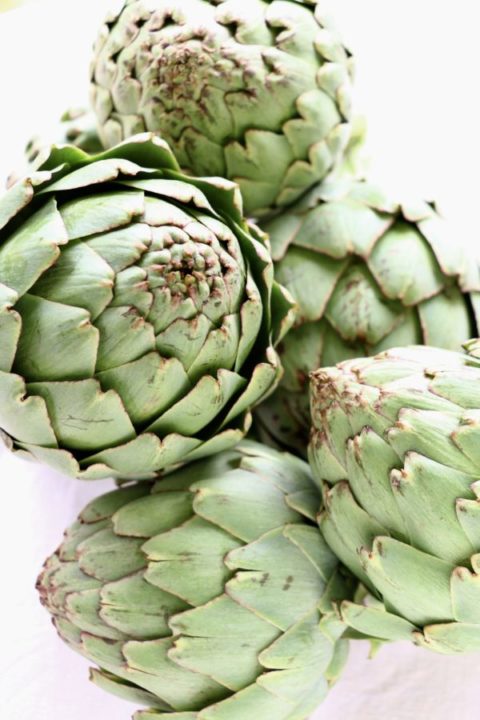 California cuisine seems to be enjoying renewed attention in the UK, not only for its multicultural fusion-cooking, but for its creativity with seasonal, interesting produce – thanks no doubt to our current interests in more adventurous vegetable cookery.
California cuisine seems to be enjoying renewed attention in the UK, not only for its multicultural fusion-cooking, but for its creativity with seasonal, interesting produce – thanks no doubt to our current interests in more adventurous vegetable cookery.
When I think of ‘California cooking’, I instantly think of what grows in that immensely varied landscape with its huge range of microclimates — and of my own salad days playing with it all when I cooked in Berkeley and Palo Alto, and had a Meyer lemon and fig tree in my garden. Almonds, avocados, artichokes, garlic… plums, grapes, boysenberries, loganberries… cornsalad, chervil, sorrel, nasturtiums….
And not just a rainbow of vegetables, fruits, herbs and edible flowers, but goats-milk cheeses, organic lamb, wild quail, fish from the Pacific…. We had salads most days, and grilled everything from baby leeks to oysters over mesquite perfumed with fennel and bay. It seemed there were endless possibilities to produce anything under that almost endless sun, and to do almost anything with it. It was enough to give any young cook the fever.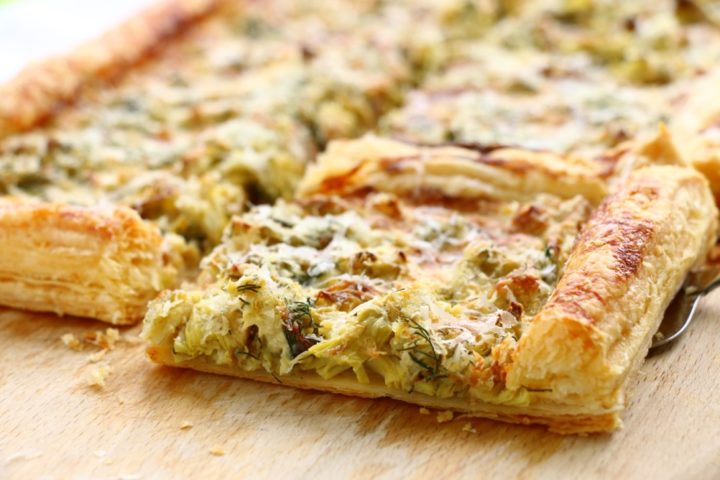
Nothing could be more Californian then and now than artichokes. Artichokes thrive in the cool nights and warm days of the coastal areas south of the San Francisco Bay area. I loved glimpsing field after untidy field of them, silver through the morning mist, on my drives to my sister’s place in Monterey, their sculptural forms and serrated foliage moving with the sea-breeze. Sometimes I’d stop at one of the artichoke houses en route for a basket of fried hearts or a few globes for us to steam for dinner.
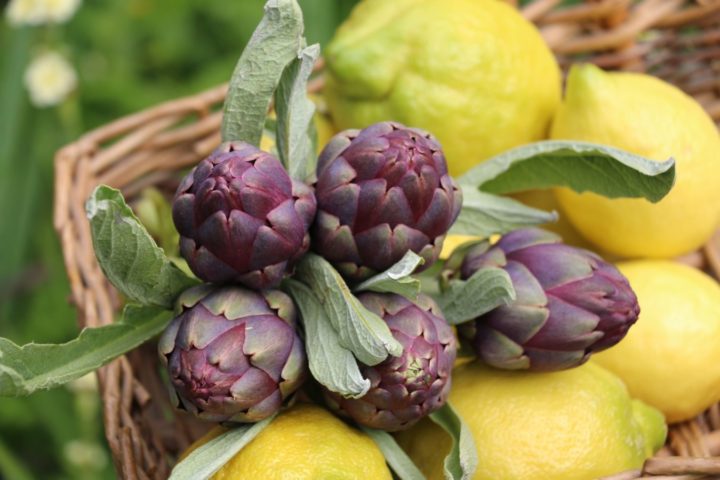 They were cheap, too. We could get 10 baby artichokes for a dollar, young enough to be chokeless and edible down to the stalks; or giant ones, big as two hands, cut fresh from the field, affordable to serve whole to a crowd or piggle down to their hearts to make into a gratin or splendid tart.
They were cheap, too. We could get 10 baby artichokes for a dollar, young enough to be chokeless and edible down to the stalks; or giant ones, big as two hands, cut fresh from the field, affordable to serve whole to a crowd or piggle down to their hearts to make into a gratin or splendid tart.
Here in the UK there are growers of beautiful organic artichokes, and of course we get good imports from the Continent, but artichokes aren’t as popular here as they deserve to be. We seem to like them from the deli in a salad, on a pizza, or with an antipasto platter, but buying a whole, naked artichoke to be cooked at home isn’t our first impulse when wandering the produce aisle. Maybe we’re not sure how to prepare them, or fit them into a meal; or maybe we’re shy of eating them with fingers (or worry that other people at the table might be).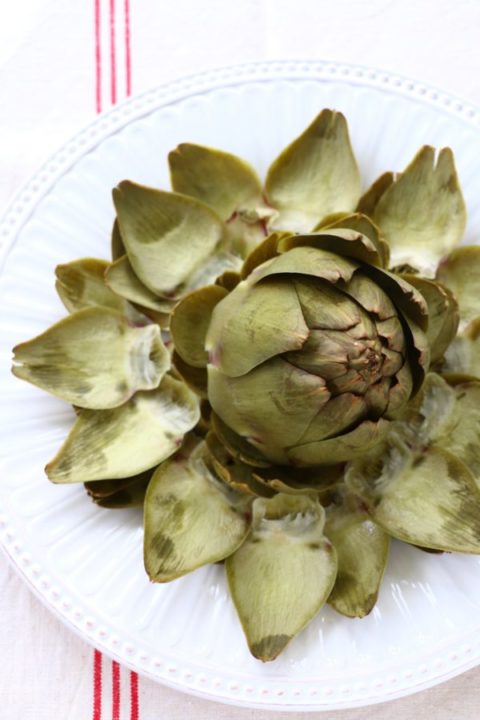 Understandable objections, all, but I’m guessing we’ll get more in tune with them as we expand our vegetable repertoire. The flavour is worth all the objections, and they’re low in calories and full of fibre and anti-inflammatory antioxidants (the flesh in the leaves is as good for you as the hearts). Really and truly, artichokes can in fact be one of the easiest special things to put in front of people. Steamed whole, they’re an honest to goodness convenience food that’s also a celebratory ritual food — to be shared at a table where everyone’s eating with their fingers and deciding how to arrange all those leaves they’ve scraped with their teeth. It’s fun! It breaks down barriers. Whatever initial consternation faced by the uninitiated — either in the kitchen by the cook (there’s no need to trim off the spiky tips), or at the table — it can just as quickly be converted to uninhibited delight, not least for the satisfaction of mastery, of navigating a rite of passage.
Understandable objections, all, but I’m guessing we’ll get more in tune with them as we expand our vegetable repertoire. The flavour is worth all the objections, and they’re low in calories and full of fibre and anti-inflammatory antioxidants (the flesh in the leaves is as good for you as the hearts). Really and truly, artichokes can in fact be one of the easiest special things to put in front of people. Steamed whole, they’re an honest to goodness convenience food that’s also a celebratory ritual food — to be shared at a table where everyone’s eating with their fingers and deciding how to arrange all those leaves they’ve scraped with their teeth. It’s fun! It breaks down barriers. Whatever initial consternation faced by the uninitiated — either in the kitchen by the cook (there’s no need to trim off the spiky tips), or at the table — it can just as quickly be converted to uninhibited delight, not least for the satisfaction of mastery, of navigating a rite of passage.
Cleaning them down to their hearts for a tart is, I warn you now so you don’t hate me later, a much messier and more time-consuming process than steaming them whole, and your compost bin will fill up quicker than you can say Blimey. But if you want to give people a real treat by doing all the work for them (no messy fingers or tablecloths), an artichoke tart fits the bill. By using only the heart, you experience the inimitable flavour of the artichoke and its most appealing texture: that meltingly tender and meaty heart. It’s the artichoke ideal.
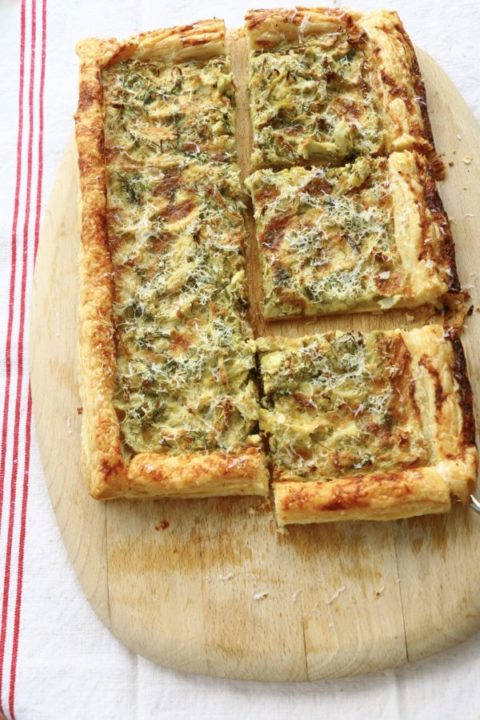 I’m sharing two variations of artichoke tart: the first uses a puff pastry base, over which is scattered sauteéd, sliced artichoke hearts bound with a small amount of rich custard covered with grated parmesan; the pastry is thin and very crispy and flaky. The second tart is deeper and more quiche-like, though the artichokes still dominate. It’s made with a parmesan shortcrust that requires blind-baking before being filled with a parmesan custard and finished in the oven. Both use the same amount of artichokes. Either tart is a lovely lunch dish with a salad, or a beautiful vegetarian starter.
I’m sharing two variations of artichoke tart: the first uses a puff pastry base, over which is scattered sauteéd, sliced artichoke hearts bound with a small amount of rich custard covered with grated parmesan; the pastry is thin and very crispy and flaky. The second tart is deeper and more quiche-like, though the artichokes still dominate. It’s made with a parmesan shortcrust that requires blind-baking before being filled with a parmesan custard and finished in the oven. Both use the same amount of artichokes. Either tart is a lovely lunch dish with a salad, or a beautiful vegetarian starter.
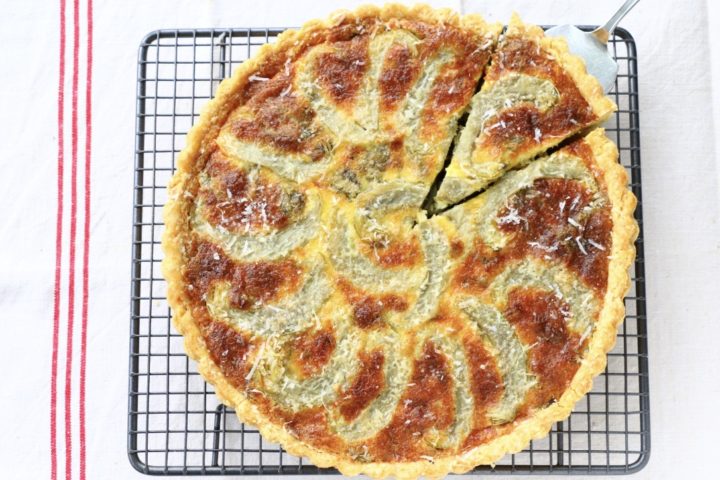 I’ve also tried using tinned artichokes, jarred artichokes in oil, and frozen artichoke hearts to make these tarts, to see if the fresh ones really are worth the effort. Well, as you’d expect, the artichokes you pare down yourself have a freshness and intensity of flavour you’ll never duplicate with the others (oh, to shop at an Italian market where the artichoke sellers do the prep for you!). But I’m pleasantly surprised that the alternatives also work if you help them along (tips in the second box below).
I’ve also tried using tinned artichokes, jarred artichokes in oil, and frozen artichoke hearts to make these tarts, to see if the fresh ones really are worth the effort. Well, as you’d expect, the artichokes you pare down yourself have a freshness and intensity of flavour you’ll never duplicate with the others (oh, to shop at an Italian market where the artichoke sellers do the prep for you!). But I’m pleasantly surprised that the alternatives also work if you help them along (tips in the second box below).
There are vegetables that take effort, no doubt about it. It seems, though, that with the trend towards eating less meat, we’re revising how we think about these ‘special-occasion vegetables’, and giving them the time we might once have allotted to a more meat-centred meal.
This is the moment to try artichokes (June through September is the season for British-grown specimens). I’ll be serving them a few more times this summer, sometimes in a tart, sometimes steamed and served with a chopped egg and herb dressing to dip the leaves into (recipe below for this, too). They’re low in calories this latter way, so are as rewarding for a solo dieter’s repast as for a social one. It’s a little treat that takes time to enjoy, so makes the meal last: time enough to take a breath and dream a little.
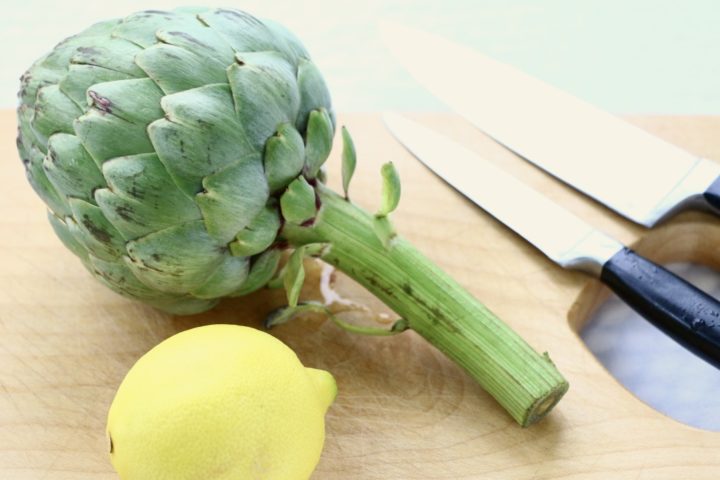 Immerse your artichokes in cool water to clean them; adding salt to the water helps to draw out any insects.
Immerse your artichokes in cool water to clean them; adding salt to the water helps to draw out any insects.
Work on a sturdy chopping board and allow plenty of space. You’ll need a sharp paring knife, and a larger cook’s knife, also sharp, plus a small spoon that’s sharp enough to extract the choke (a grapefruit spoon is ideal, but any sturdy teaspoon with a thinner edge will do). Have lemons at the ready to rub over the cut surfaces of the artichokes as you work, to prevent discolouration. Raw artichokes quickly turn dark when their flesh is exposed to air. Also have handy a large bowl of well-acidulated water to keep the trimmed artichokes in: add the juice of two or three lemons to a bowl of cool water.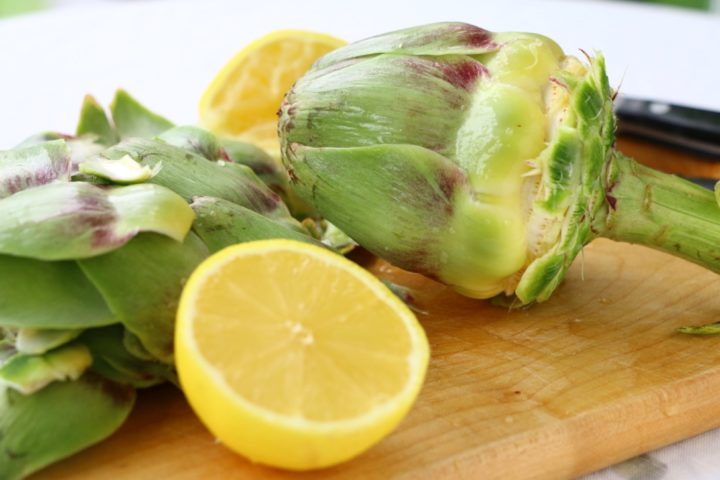 Keep the long stalks on for now, as it makes it easier to hold the artichoke as you work. Start by pulling off the outer leaves with your fingers, starting at the bottom of the artichoke, and lubricating all cut surfaces well with the lemon as you go. Continue all around the artichoke twisting one leaf off at a time. Keep removing the coarse outer leaves until the pale-green inner leaves are revealed at the base. Judge this by looking at the bottom where the leaves attach to the base, as the top ‘cone’ will still look a darker green.
Keep the long stalks on for now, as it makes it easier to hold the artichoke as you work. Start by pulling off the outer leaves with your fingers, starting at the bottom of the artichoke, and lubricating all cut surfaces well with the lemon as you go. Continue all around the artichoke twisting one leaf off at a time. Keep removing the coarse outer leaves until the pale-green inner leaves are revealed at the base. Judge this by looking at the bottom where the leaves attach to the base, as the top ‘cone’ will still look a darker green.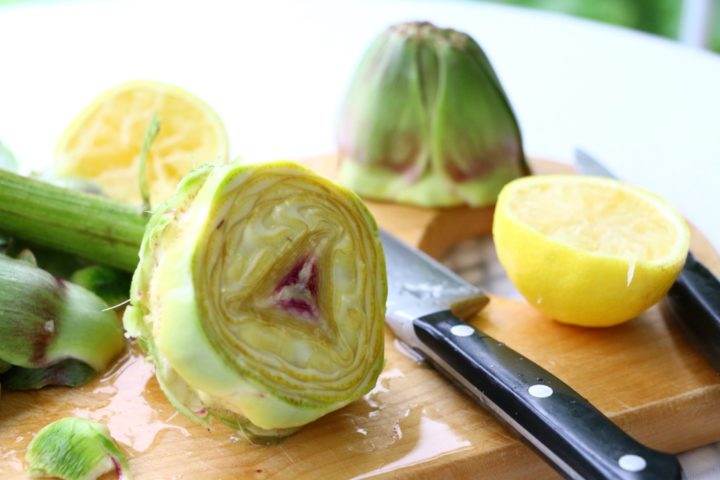 When you’ve snapped off the tougher, outer leaves so only the pale green leaves are visible at the base, cut the top cone off the artichoke, about 2cm (3/4-inch) above the base. You want to leave on the meaty part of the leaves at the base (this is the part of the leaf that you scrape with your teeth when eating them whole). Rub well with lemon juice. Now you can trim the long stem to about 2.5cm (1 inch) of the base.
When you’ve snapped off the tougher, outer leaves so only the pale green leaves are visible at the base, cut the top cone off the artichoke, about 2cm (3/4-inch) above the base. You want to leave on the meaty part of the leaves at the base (this is the part of the leaf that you scrape with your teeth when eating them whole). Rub well with lemon juice. Now you can trim the long stem to about 2.5cm (1 inch) of the base.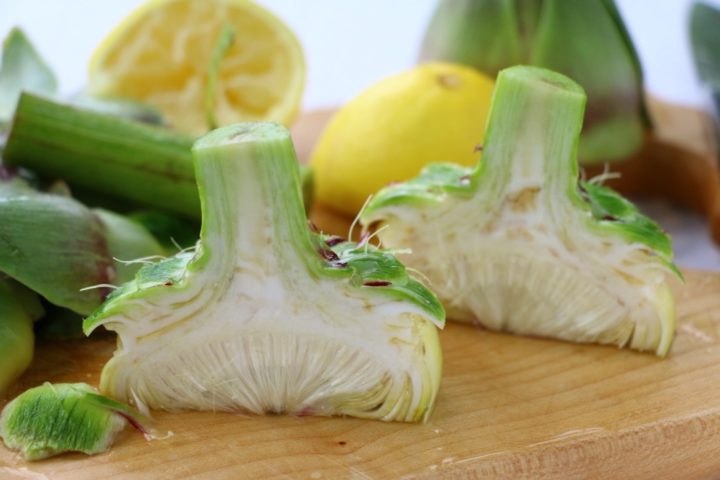 Place the artichoke so the flat side is in contact with the chopping board, and cut downwards so you have two equal halves in cross-section (again, use plenty of lemon juice as you cut). This makes it easier to access the choke, and to trim off the remaining dark-green scales and outer part of the stem.
Place the artichoke so the flat side is in contact with the chopping board, and cut downwards so you have two equal halves in cross-section (again, use plenty of lemon juice as you cut). This makes it easier to access the choke, and to trim off the remaining dark-green scales and outer part of the stem.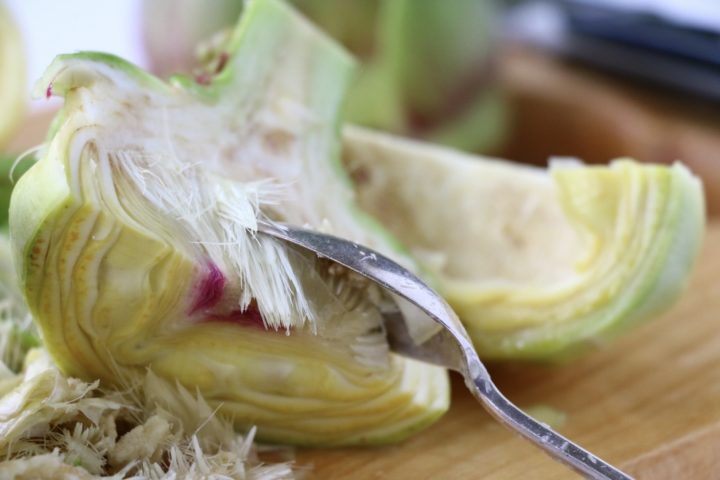 Using the paring knife, carefully trim away all the dark- or bright-green bits of outer-stem and leaf. Then switch to the spoon and use it to gently remove the fibrous inner fluff, known as the choke, from each half artichoke in turn. You should be able to see quite clearly where the fibres start to come away from the artichoke’s base. Don’t dig in too deeply as you don’t want to waste any of the heart, but do make sure to get every last bit of fine hair, as it really can make you choke if you miss any! Discard all the debris to keep your work-surface clean, and give the cleaned hearts a rinse (and another rub of lemon juice).
Using the paring knife, carefully trim away all the dark- or bright-green bits of outer-stem and leaf. Then switch to the spoon and use it to gently remove the fibrous inner fluff, known as the choke, from each half artichoke in turn. You should be able to see quite clearly where the fibres start to come away from the artichoke’s base. Don’t dig in too deeply as you don’t want to waste any of the heart, but do make sure to get every last bit of fine hair, as it really can make you choke if you miss any! Discard all the debris to keep your work-surface clean, and give the cleaned hearts a rinse (and another rub of lemon juice).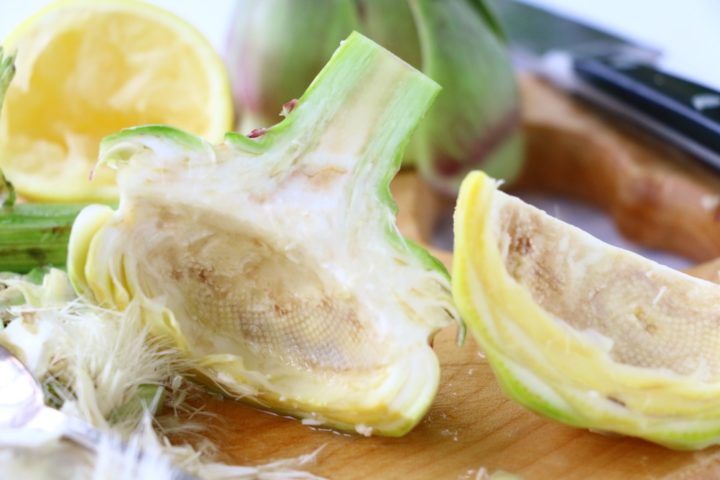 When the choke has been removed, you’ll be left with half a little ‘cup’ of artichoke heart and its frill of pale-green leaves. At this point trim off any remaining hard bits of leaf or stem with the paring knife (you can see some remaining in the one above, still to be trimmed).
When the choke has been removed, you’ll be left with half a little ‘cup’ of artichoke heart and its frill of pale-green leaves. At this point trim off any remaining hard bits of leaf or stem with the paring knife (you can see some remaining in the one above, still to be trimmed). 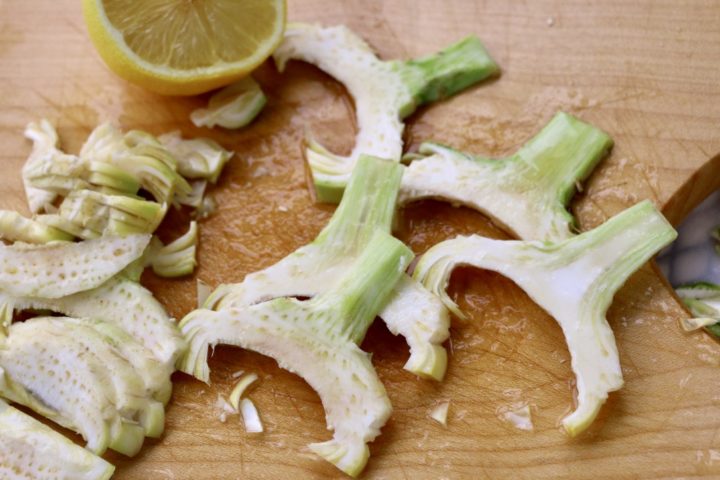 Once the chokes are removed and the hearts are nicely trimmed, slice them thinly and cook immediately, or keep in acidulated water. Trim off any remaining stem or outer leaf that feels at all hard.
Once the chokes are removed and the hearts are nicely trimmed, slice them thinly and cook immediately, or keep in acidulated water. Trim off any remaining stem or outer leaf that feels at all hard.
Tinned and frozen are good value, and take on seasoning well. The hearts in oil are more expensive and vary in how seasoned they are. If you want to use them in a tart, they would work best in the puff-pastry version that has less custard (the oil can cause separation).
Look for any darker green bits of outer leaf that are too coarse and remove them. Almost all pre-prepared artichokes will have a few bits you would find tough, so take a minute to look them over.
You may need to rinse them if they feel at all gritty.
Whether you rinse or not, you’ll have to drain them very well of water or oil. Squeeze them gently upside down to get rid of the excess, then quarter and lay them cut-side down on sturdy kitchen towels. Roll up the towels and apply gentle pressure to extract any last water or oil. Unroll, make sure the artichokes are good and dry, and then proceed to slice thinly for the recipe.
Taste and season well with sea salt and freshly ground black pepper.
RECIPES
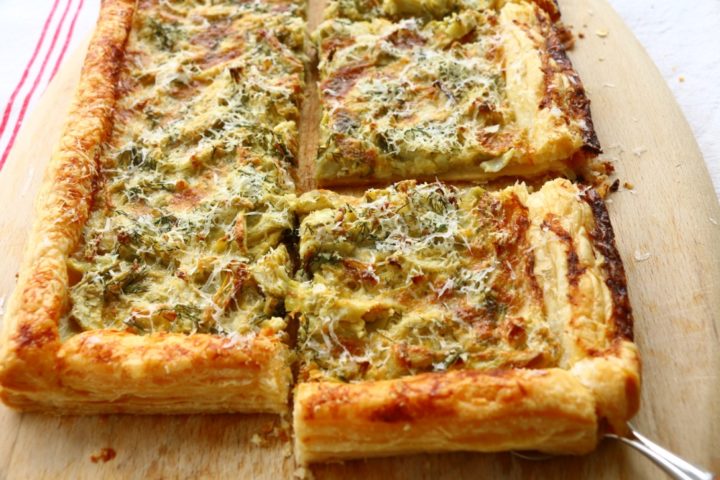 I. Puff pastry artichoke tart
I. Puff pastry artichoke tart
Serves 4-6
Adapted with alterations from Alice Waters, The Chez Panisse Menu Cookbook (1982)
Ingredients
- One-third of the puff pastry recipe here (or one 320g sheet of all-butter ready-made puff pastry)
- 6 large whole artichokes, rinsed well (or 240g / 8.5 ounces drained weight of tinned, frozen or jarred artichoke hearts: see TIPS in the box above for using these as substitutes for fresh)
- 2-3 lemons
- 1 tablespoon unsalted butter
- 1 tablespoon olive oil
- 80ml (⅓ cup) heavy cream
- 1 large egg yolk
- 1 teaspoon Dijon mustard
- 1 teaspoon finely grated lemon zest
- 2 tablespoons chopped herbs (dill, tarragon, parsley and/or chervil are all good here)
- About 1 teaspoon flaky sea salt and a few grinds of freshly ground black pepper, or more to taste
- 30g finely grated parmesan cheese
Directions
- Make the pastry shell: roll the puff pastry into a rectangle 23 x 28cm (9 x 11 inches) and to a 3mm thickness (1/8 inch); transfer it to a parchment-lined baking sheet. (If using ready-rolled puff pastry, lay it as is onto the parchment-lined baking sheet). Build a pastry-border to contain the filling by using a sharp knife to trim off a 2.5cm wide (1-inch) strip of pastry from each of the four sides. Moisten the edges of the pastry rectangle with a little water, cream or egg white, and lay the matching pastry strips on top, trimming off the excess at the corners. Refrigerate the pastry shell until you’re ready to assemble the tart.
- Following the instructions in the box above, pare the six artichokes down to their hearts, rubbing plenty of lemon juice on the cut surfaces to avoid discolouration. Keep the cleaned artichoke hearts in acidulated water until ready to cook. (If you are using pre-prepared artichoke hearts, drain them well and pat them dry, following the TIPS in the box above.)
- Slice the hearts thinly (to about 3mm or 1/8 inch thick); this makes the tart much easier to slice through and eat. Sauté the sliced artichoke hearts in the butter and olive oil over medium heat until just tender, about 5 minutes (watch that they don’t catch). Season with most of the salt and pepper. Cool to room temperature. (If using pre-prepared hearts, there is no need to cook them, but do season them well.)
- While the hearts are cooling, make the custard in a measuring cup with a pouring spout: using a fork, mix together until well-blended the cream, egg yolk, mustard, herbs, lemon zest and the remaining salt and pepper.
- Heat the oven to 200C / 400F.
- Fill the tart shell with the cooled artichoke slices, staying within the raised pastry border. Slowly and carefully pour the custard over the artichokes, giving it time to soak into the nooks and crannies, and being careful not to spill over the border.
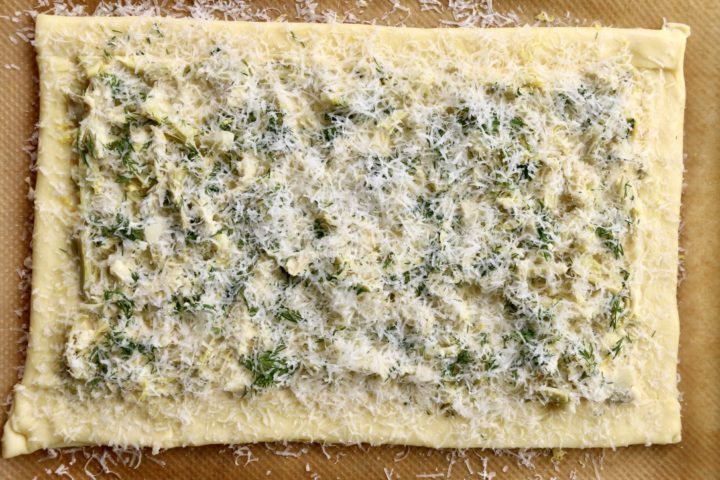
- Sprinkle the grated parmesan over the filled tart, reserving just a little to scatter over when the tart is finished.
- Bake for an initial 15 minutes at 200C / 400F. Turn down to 175C / 350F and rotate the baking sheet once in the oven to promote even browning. Bake for another 25-30 minutes or until the pastry is crisp on top and bottom, and golden brown. Serve immediately. (Any leftovers are best re-heated in a moderate oven for 5-7 minutes.)
* * * * *
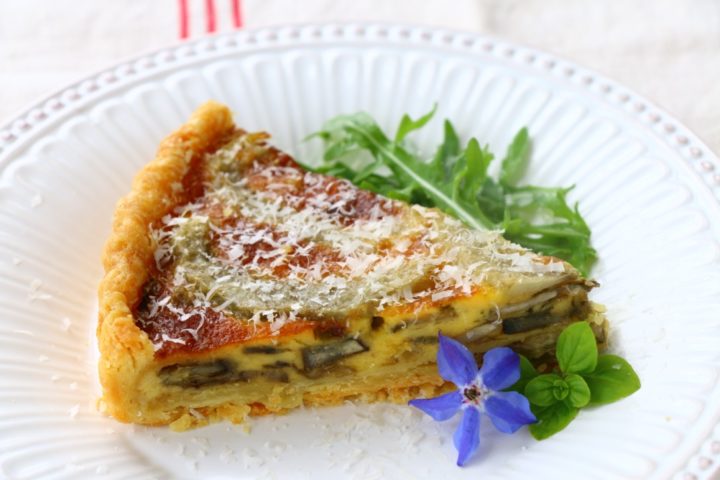 II. Artichoke tart with parmesan short-crust
II. Artichoke tart with parmesan short-crust
Serves 6-8
This version of artichoke tart uses virtually the same custard filling as the one above made with puff-pastry, but it uses more of it for a deeper, more quiche-like (and richer) tart. This one also adds a quantity of grated parmesan to the custard, as well as scattering some on top of the tart. The amount of artichokes used is the same as in the puff-pastry version.
Ingredients
- One parmesan short-crust recipe here
- 6 large whole artichokes, rinsed well (or 240g / 8.5 ounces drained weight of tinned, frozen or jarred artichoke hearts: see TIPS in the box above for using these as substitutes)
- 2-3 lemons
- 1 tablespoon unsalted butter
- 1 tablespoon olive oil
- 240ml (1 cup) heavy cream
- 3 large egg yolks
- 2 teaspoons Dijon mustard
- 1 teaspoon finely grated lemon zest
- 3 tablespoons chopped herbs (dill, tarragon, parsley and/or chervil are all good here)
- 1 teaspoon flaky sea salt and ¼ teaspoon freshly ground black pepper, or more to taste
- 80g finely grated parmesan cheese (divided into 60g and 20g)
Directions
- Lightly butter a 20cm (8-inch) tart tin with a removeable bottom. Roll the parmesan short-crust between sheets of clingfilm into a 25cm (10-inch) circle, about the thickness of a penny (about 3mm or 1/8 inch). Remove the top layer of clingfilm and flip the pastry into the buttered tin, guiding it in to fit. Peel off the remaining layer of cling film, and tuck the pastry into the tin well, especially into the sides. Trim off the overhanging pastry by running a knife along the edge of the tin (or by rolling the rolling pin over the top of the tin). Prick the bottom a few times with a fork and refrigerate the pastry shell for at least an hour. [More TIPS here for making short-crust pastry.]
- Heat the oven to 175C / 350F. Scrunch up a very lightly buttered piece of parchment paper, unscrunch it, and place it (butter-side down) into the pastry shell, and fill it with pie weights. Pre-bake the shell for 15 minutes until it has begun to set and has lost its raw appearance. Lift out the parchment paper with the pie weights, and return the pastry shell to the oven to bake for another 10 minutes or until it has a pale golden colour on the base.
- Following the instructions in the box above, pare the six artichokes down to their hearts, rubbing plenty of lemon juice on the cut surfaces to avoid discolouration. Keep the cleaned artichoke hearts in acidulated water until ready to cook. (If you are using pre-prepared artichoke hearts, drain them well and pat them dry, following the TIPS in the box above.)
- Slice the hearts thinly (to about 3mm or 1/8 inch thick); this makes the tart much easier to slice through and eat. Reserve 16 of the best inner slices of artichoke for decoration, and blanch them in boiling water for 2 to 3 minutes or until just tender. Refresh under cold water to stop the cooking and pat dry. Set aside.
- Sauté the remaining sliced artichoke hearts in the butter and olive oil over medium heat until just tender, about 5 minutes (watch that they don’t catch). Season with ½ teaspoon of the salt and a good pinch of the pepper. Cool to room temperature. (If using pre-prepared hearts, there is no need to cook them, but do season them well.)
- While the hearts are cooling, make the custard in a measuring cup with a pouring spout: using a fork, mix together until well-blended the cream, egg yolks, mustard, herbs, lemon zest, 60g of the parmesan cheese, and the remaining salt and pepper.
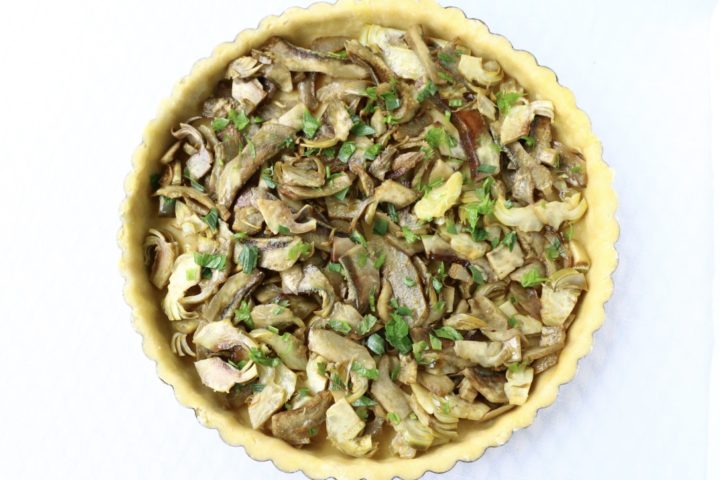
- Heat the oven to 175C / 350F. Fill the part-baked tart shell with the cooled, sauteéd artichoke slices.
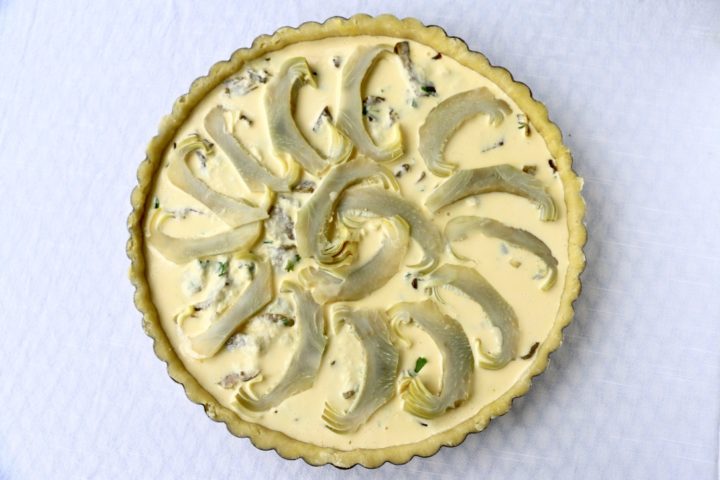
- Carefully pour the custard over the artichokes. Decorate the top of the custard with the reserved inner slices of artichoke.
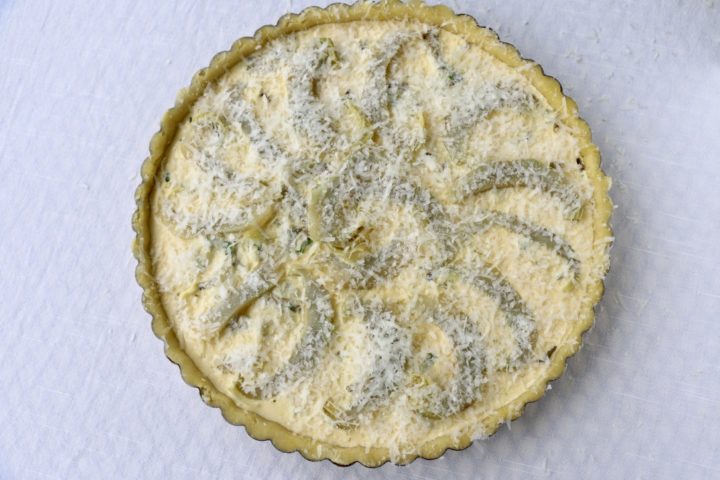
- Sprinkle on the remaining parmesan, reserving just a little to scatter over when the tart has been baked. Bake for an initial 15 minutes; rotate the tart to ensure even cooking, and bake for a further 15-20 minutes — or until the custard has set and the crust and parmesan cheese on top have turned golden brown. A skewer inserted in the centre should come out almost clean.
- Cool for 5-10 minutes before cutting, and serve warm.
* * * * *
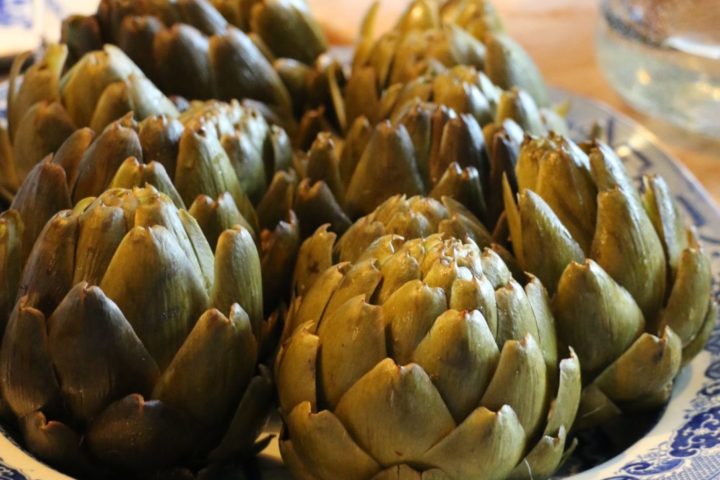 III. Steamed whole artichokes with herb dipping sauce
III. Steamed whole artichokes with herb dipping sauce
For the artichokes
- Serve one whole large artichoke per person.
- While preparing them for the pot, have at the ready a cut lemon. You will need to rub lemon juice over any cut surfaces of the artichoke to prevent discolouration. If you are preparing several, or are going to trim off the tips of the leaves, also have a large bowl of water handy, acidulated with more lemon juice.
Directions
- Immerse the artichokes in plenty of cool water for a few minutes to clean them. Adding salt to the water will draw out any insects.
- Cut off the stem right to the base of the artichoke and trim off the few tough leaves at the bottom. You want the artichoke to sit level on the plate.
- I don’t snip off the spiny tips of the leaves, as you eat the flesh from the other end; and leaving the leaves intact gives you more to hold onto. But if you do want to remove them, use a sharp pair of kitchen shears to nip off just the tips of each exposed leaf, and rub every cut surface generously with a halved lemon as soon as you cut. Likewise, I don’t trim off the tops of the artichoke. This is sometimes done to remove the tips of the closed leaves and give the artichokes a flat top to reveal the choke. Do so if you please for a more formal presentation; and if you do, trim them with a sharp knife as close to cooking as possible, rub well with the cut lemon, and keep them in acidulated water until cooking.
- Use a large enough pan to accommodate the artichokes and make sure it’s deep enough so the pan can take the lid. A steamer insert is ideal to keep the artichokes from sitting in water. If you do find they sit proud of the pan, you could up-end a larger pan to sit over the artichokes as an improvised lid.
- Bring the water to a boil, set the artichokes in the pan on top of a steamer, and cover. Steam the artichokes until the base is tender enough for a skewer to penetrate the base with just a little resistance, and for a leaf to pull out easily. This takes anywhere from 25-40 minutes depending on the size of the artichoke. Don’t overcook them, as the hearts shouldn’t be at all mushy, and they will continue cooking in the residual heat.
- Serve a whole artichoke per person, on a plate large enough to take the debris. Give each person a spoon to remove the choke, and a knife and fork to eat the heart. Finger bowls can be useful, too.
- To eat them, pull the leaves off the artichoke with your fingers, starting at the bottom of the artichoke, and scrape the meaty ends of the leaf with your teeth, dipping into the sauce as you please. Keep going until you get to the thin inner leaves that protect the choke, and pull them away and discard. Scrape out the choke with a spoon and discard. Savour the tender heart.
Herb dipping sauce for steamed artichokes
Serves 1-2, depending on appetite
This is my favourite dipping sauce to have with steamed artichokes, as it’s full of flavour and healthy ingredients, and isn’t high in calories (as are melted butter or herb mayonnaise, which are also delicious, of course). This isn’t a loose sauce, though you could add extra olive oil if you wanted it to be, and adjust the acidic elements accordingly.
Ingredients
- 2 hard boiled eggs, chopped
- 2 tablespoons chopped herbs (dill, chervil, parsley, tarragon, chives are all good in combination or alone)
- 1 teaspoon Dijon mustard
- 1½ teaspoons lemon juice
- 1 teaspoon drained capers (rinsed and soaked if salt-cured)
- 2 tablespoons extra virgin olive oil
- Optional: 2 anchovies, mashed
- Sea salt and ground black pepper to taste
Directions
- Add everything except the boiled eggs and seasoning to a food processor and blitz together until fairly smooth.
- Stir in the chopped eggs and season to taste, adding more salt, pepper, or lemon juice as needed.
- Serve a little bowl of sauce to each person.
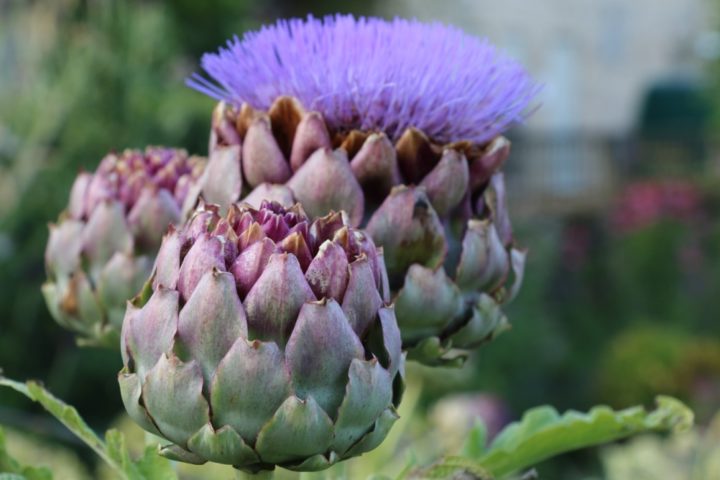
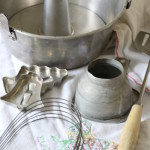




 Tour D’Argent: a remembrance of things past at today’s prices
Tour D’Argent: a remembrance of things past at today’s prices Apricots, les abricots
Apricots, les abricots I used to cook in a piggery
I used to cook in a piggery




 Seed cake and story
Seed cake and story





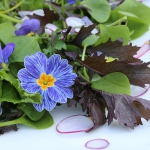





 Easter is late this year
Easter is late this year
Thank you so much for this amazing comprehensive and super informative post! I am one of those people who often admires fresh whole artichokes in the grocery store from afar but after reading your post, I feel inspired to give them a go! Thank you again!
Thank you for your kind comment, Katerina. I hope you do try them and find a new favourite! Have fun!